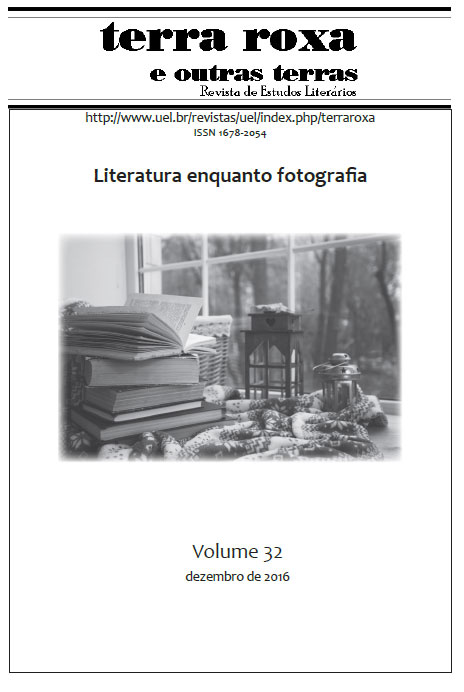The relationship intrinsic between text and image in "Mineirinho", by Clarice Lispector
DOI:
https://doi.org/10.5433/1678-2054.2016v32p43Keywords:
Mineirinho, Text, Image, Language, Clarice LispectorAbstract
The retrieval of the visual, resulting from the actions of senses and recovered by memory, can unleash different feelings in relation to a specific image. Anchored in this affirmative, the study intends to discuss about the vision of the writer Clarice Lispector, before the death of the criminal "Mineirinho", and the reconstruction of this fact, in her chronicle, from the reports and journalistic descriptions, as well as from the image of Mineirinho's death, printed by some newspapers of the period, in the architecture of her discourse that associates, differently, the analogous relationship between text and image. In order to reach this understanding, we explore, through the mechanisms of language, communicative processes that will assist the dialogic construction existing between the production of literary discourse, and her relationship with the psychical resources of the memory in her performance of retrieval and capture of information/images, as a result of innumerable sensations caused by brutality of actions, connected to the impact of photographic register of Mineirinho's body with gunshot wounds. In this sense, the theories of Mikhail Bakthin (1997), Roman Jackobson (2003), G. E Lessing (1998), Luiz Alfredo Garcia-Roza (1984) on Freudian theories, and Alfredo Bosi (1974) will constitute the more specific basis of our work.Downloads
References
BOSI, ALFREDO. "Imagem e discurso". Discurso (São Paulo), v. 5, n. 5, p. 65-85, 1974. Disponível em . Acesso em 02 jun. 2016.
DONDIS, Donis A. Sintaxe da linguagem visual. São Paulo: Martins Fontes, 2003.
GARCIA-ROZA, Luiz Alfredo. Freud e o inconsciente. Rio de Janeiro: Zahar, 1984.
JACKOBSON, Roman. Línguística e comunicação. Trad. Izidoro Blikstein e José Paulo Paes. São Paulo: Cutrix, 2003.
LESSING, G.E. Laocoonte: ou sobre as fronteiras da poesia e da pintura. Trad. Marcio Seligmann-Silva. São Paulo: Iluminuras, 1998.
LISPECTOR, Clarice. Outros Escritos. Teresa Montero e Lícia Manzo, orgs. Rio de Janeiro: Rocco, 2005.
LISPECTOR, Clarice. Para não esquecer. São Paulo: Rocco, 1999.
Mineirinho morreu com oração e recorte no bôlso. Diário Carioca: jornal eletrônico da Biblioteca Nacional Digital, Rio de Janeiro, ed. 10468 (1), p.10, maio 1962. Disponível em . Acesso em 10 maio 2016.
Mineirinho sem sete vidas. JornaldoBrasil: jornal eletrônico da Biblioteca Nacional Digital, Rio de Janeiro, ed. 00099, p. 1, mai., 1962. Disponível em . Acesso em 10 maio 2016.
OLIVEIRA, Andrey Pereira de. Laooconte, de Lessing, passagem obrigatória: algumas reflexões sobre palavra e imagem. Graphos (João Pessoa), vol. 12, n. 2, 2010. Disponível em . Acesso em 01 jun. 2016.
RODRIGUES, Aline. Blog Tribarte Clarice Lispector em defesa dos direitos humanos, 2014. Disponível em . Acesso em 20 maio 2016.
ROSENBAUM, Yudith. A ética na literatura: leitura de "Mineirinho", de Clarice Lispector. Estudos Avançados (São Paulo), v. 24, n. 69, p. 169-182, 2010. Disponível em . Acesso em 19 jul. 2017.
Downloads
Published
How to Cite
Issue
Section
License
Copyright (c) 2016 Terra Roxa e Outras Terras: Revista de Estudos Literários

This work is licensed under a Creative Commons Attribution 4.0 International License.
Authors who publish in this journal agree to the following terms:
a) The authors retain the copyright and grant the journal the right of first publication, the work being simultaneously licensed under the Creative Commons Attribution-NonCommercial 4.0 International License, allowing the sharing of the work with acknowledgment of the authorship of the work and initial publication in this journal.
b) Authors are authorized to assume additional contracts separately, for non-exclusive distribution of the version of the work published in this journal (eg, publish in an institutional repository or as a book chapter), with acknowledgment of authorship and initial publication in this journal.
c) Authors are allowed and encouraged to publish and distribute their work online (e.g. in institutional repositories or on their personal page) after the editorial process, as this can generate productive changes as well as increase impact and citation of the published work (See The Effect of Open Access).
d) The authors of the approved works authorize the journal to, after publication, transfer their content for reproduction in content indexers, virtual libraries and the like.
e) The authors assume that the texts submitted for publication are of their original creation, taking full responsibility for their content in case of any objection by third parties.




















